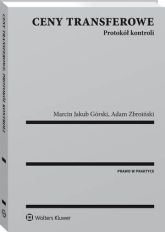About the Book
The priority objective, which guided the Authors of this book, is to garner interest in the Transfer Pricing and increasing awareness of the reader in this area. This does not mean that the group of potential recipients is limited to specialists whose previous contact with the subject was negligible. The book is mainly based on OECD Guidelines and Polish Tax Acts.
The Authors wrote the book in an innovative form of quasi–fiscal audit protocol. This treatment had to somehow make the book more attractive, but above all, the Authors had intended to emphasize the relationship between the discipline of Transfer Pricing to that of business taxation. The indication of this compound presents the tax consequences of the use of Transfer Pricing in the opinion of the Authors and can add additional value for people who have experience in the field of Transfer Pricing including entrepreneurs, accountants, tax advisors and tax administration. In the first part of the book, Authors present the procedural environment in which Transfer Pricing analysis process is performed. Then, a number of practical aspects, including the consequences of failure to submit Transfer Pricing Documentation and sample catalog of documents that may be controlling.
The Authors recalled the thesis of jurisprudence and scientific doctrine. It also presents an extensive, hypothetical functional analysis of the company (including assets and risks), the valuation of the arm's length principle for intangible assets (licenses and trademark and technology), and the valuation of the company's viability (benchmarking study of ROA indicator), which in many places is accompanied by additional practical comments.
The most important part of the book is a quasi–fiscal audit protocol, which, thanks to the fact that recalls its structure and language of the fiscal audit protocol, has enabled a concise and logically consistent presentation of a possible methodology for the study of Transfer Pricing.
Main companies
occurring in the book
State Company Production Plant (SCPP)- a company created in the mid 50's of the twentieth century. Products enjoyed recognition of domestic consumers. However, it made political transformation and the opening to the free market, taking place in the early 90s - those turned out to be too difficult to attempt. A unique opportunity for SCPP was to invest in the establishment of capital by the Group Leelee and the accompanying enterprise restructuring.
Leelee Poland Sp. o.o. - The subsidiary entity of the Group Leelee. A large Polish company engaged in the production and distribution of cosmetics and hygiene products. Leelee Poland uses in production processes trademarks and licenses Leelee Legal S.A.R.L. It has its own shops Beauty salons Glamour. It owns the trademark and licenses for the production of modern biological skin Bioderma.
Leelee Poland Branch Ltd - A subsidiary of Leelee Poland sp. Z o.o. entity responsible for the development, production and distribution of the epidermis biological BioDermy.
Leelee Polish distribution in liquidation Ltd - The company is liquidated is a remnant of the archaic structure of the distribution PZPCG. The entity is not operating.
Leelee DE GmbH - one of the subsidiaries based in Germany dedicated to the distribution activities in the group Leelee. Distributes the entire range of the Group's products Leelee. The company has distribution centers on the Polish and European markets. The main recipient of branded products from Leelee Leelee Poland Ltd.
Leelee Sui - the parent company based in Switzerland, the main company of the group, the owner, directly or indirectly other entities in the group Leelee.
Leelee Legal S.A.R.L. - subsidiary company, based in Luxembourg, incorporated under the laws of the Duchy of Luxembourg, dealing with intellectual property management group Leelee. Licensor trademarks, licenses and other intangible assets.
